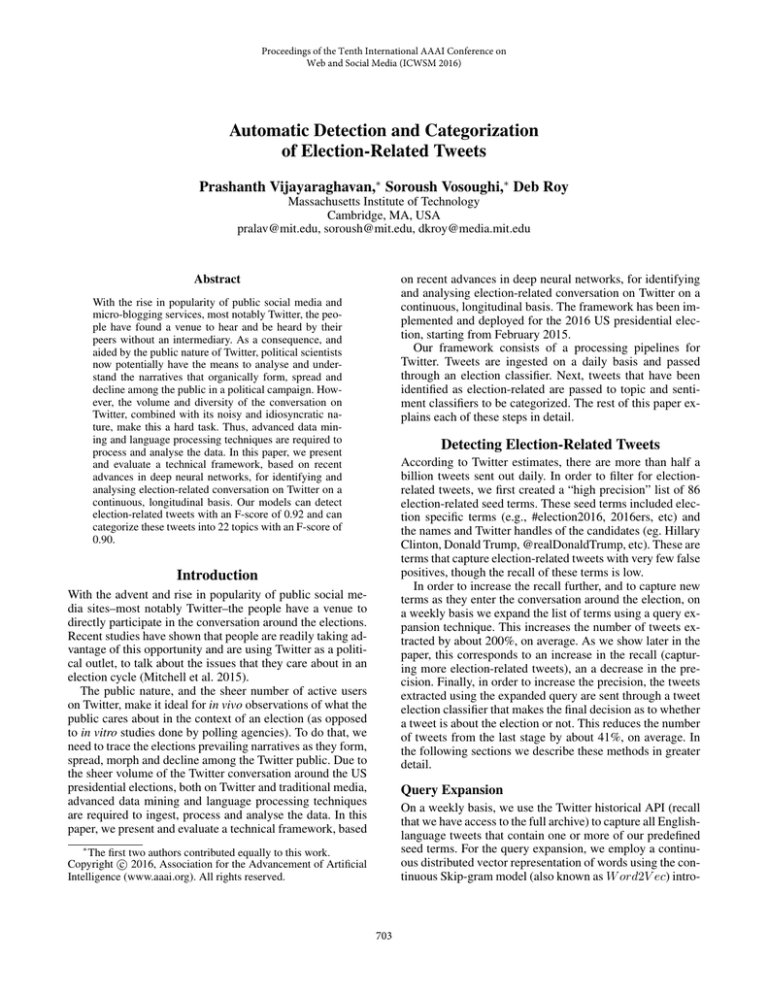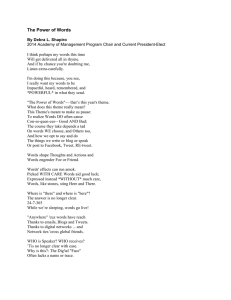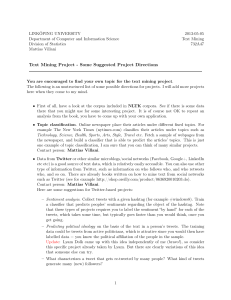
Proceedings of the Tenth International AAAI Conference on
Web and Social Media (ICWSM 2016)
Automatic Detection and Categorization
of Election-Related Tweets
Prashanth Vijayaraghavan,∗ Soroush Vosoughi,∗ Deb Roy
Massachusetts Institute of Technology
Cambridge, MA, USA
pralav@mit.edu, soroush@mit.edu, dkroy@media.mit.edu
on recent advances in deep neural networks, for identifying
and analysing election-related conversation on Twitter on a
continuous, longitudinal basis. The framework has been implemented and deployed for the 2016 US presidential election, starting from February 2015.
Our framework consists of a processing pipelines for
Twitter. Tweets are ingested on a daily basis and passed
through an election classifier. Next, tweets that have been
identified as election-related are passed to topic and sentiment classifiers to be categorized. The rest of this paper explains each of these steps in detail.
Abstract
With the rise in popularity of public social media and
micro-blogging services, most notably Twitter, the people have found a venue to hear and be heard by their
peers without an intermediary. As a consequence, and
aided by the public nature of Twitter, political scientists
now potentially have the means to analyse and understand the narratives that organically form, spread and
decline among the public in a political campaign. However, the volume and diversity of the conversation on
Twitter, combined with its noisy and idiosyncratic nature, make this a hard task. Thus, advanced data mining and language processing techniques are required to
process and analyse the data. In this paper, we present
and evaluate a technical framework, based on recent
advances in deep neural networks, for identifying and
analysing election-related conversation on Twitter on a
continuous, longitudinal basis. Our models can detect
election-related tweets with an F-score of 0.92 and can
categorize these tweets into 22 topics with an F-score of
0.90.
Detecting Election-Related Tweets
According to Twitter estimates, there are more than half a
billion tweets sent out daily. In order to filter for electionrelated tweets, we first created a “high precision” list of 86
election-related seed terms. These seed terms included election specific terms (e.g., #election2016, 2016ers, etc) and
the names and Twitter handles of the candidates (eg. Hillary
Clinton, Donald Trump, @realDonaldTrump, etc). These are
terms that capture election-related tweets with very few false
positives, though the recall of these terms is low.
In order to increase the recall further, and to capture new
terms as they enter the conversation around the election, on
a weekly basis we expand the list of terms using a query expansion technique. This increases the number of tweets extracted by about 200%, on average. As we show later in the
paper, this corresponds to an increase in the recall (capturing more election-related tweets), an a decrease in the precision. Finally, in order to increase the precision, the tweets
extracted using the expanded query are sent through a tweet
election classifier that makes the final decision as to whether
a tweet is about the election or not. This reduces the number
of tweets from the last stage by about 41%, on average. In
the following sections we describe these methods in greater
detail.
Introduction
With the advent and rise in popularity of public social media sites–most notably Twitter–the people have a venue to
directly participate in the conversation around the elections.
Recent studies have shown that people are readily taking advantage of this opportunity and are using Twitter as a political outlet, to talk about the issues that they care about in an
election cycle (Mitchell et al. 2015).
The public nature, and the sheer number of active users
on Twitter, make it ideal for in vivo observations of what the
public cares about in the context of an election (as opposed
to in vitro studies done by polling agencies). To do that, we
need to trace the elections prevailing narratives as they form,
spread, morph and decline among the Twitter public. Due to
the sheer volume of the Twitter conversation around the US
presidential elections, both on Twitter and traditional media,
advanced data mining and language processing techniques
are required to ingest, process and analyse the data. In this
paper, we present and evaluate a technical framework, based
Query Expansion
On a weekly basis, we use the Twitter historical API (recall
that we have access to the full archive) to capture all Englishlanguage tweets that contain one or more of our predefined
seed terms. For the query expansion, we employ a continuous distributed vector representation of words using the continuous Skip-gram model (also known as W ord2V ec) intro-
∗
The first two authors contributed equally to this work.
c 2016, Association for the Advancement of Artificial
Copyright Intelligence (www.aaai.org). All rights reserved.
703
Candidate Seed Term
Mike Huckabee
Carly Fiorina
Hillary Clinton
Donald Trump
duced by Mikolov et al. (Mikolov et al. 2013). The model is
trained on the tweets containing the predefined seed terms
to capture the context surrounding each term in the tweets.
This is accomplished by maximizing the objective function:
|V |
1 |V | n=1
log p(wn+j |wn )
Exapanded Terms
ckabee, fuckabee, hucka, wannabee
failorina, #fiorinas, dhimmi,fiorin
#hillaryforpotus, hitlery, hellary
#trumptheloser, #trumpthefascist
Table 1: Examples of expanded terms for a few candidates.
(1)
−c≤j≤c,j=0
70
f
where |V | is the size of the vocabulary in the training set and
c is the size of context window. The probability p(wn+j |wn )
is approximated using the hierarchical softmax introduced
and evaluated by Morin and Bengio (2005). The resultant
vector representation captures the semantic and syntactic information of the all the terms in the tweets which, in turn,
can be used to calculate similarity between terms.
Given the vector representations for the terms, we calculate the similarity scores between pairs of terms in our vocabulary using cosine similarity. For a term to be short-listed
as a possible extension to our query, it needs to be mutually
similar to one of the seed terms (i.e., the term needs to be in
the top 10 similar terms of a seed term and vice versa). The
top 10 mutually similar terms along with noun phrases containing those terms are added to the set of probable election
query terms.
However, there could potentially be voluminous conversations around each of the expanded terms with only a small
subset of the conversation being significant in the context
of the election. Therefore, the expanded terms are further
refined by extracting millions of tweets containing the expanded terms, and measuring their election significance metric ρ. This is the ratio of number of election-related tweets
(measured based on the presence of the seed terms in the
tweets) to the total number of retrieved tweets. For our system, the terms with ρ ≥ 0.3 form the final set of expanded
query terms. The ρ cut-off can be set based on the need for
precision or recall. We set the cut-off to be relatively low
because as we discuss in the next section, we have another
level of filtering (an election classifier) that further increases
the precision of our system.
The final list of terms generated usually includes many
diverse terms, such as terms related to the candidates, their
various Twitter handles, election specific terms (e.g., #election2016), names and handles of influential people and
prominent issue-related terms and noun phrases (e.g., immigration plan). As mentioned earlier, the query is expanded
automatically on a weekly basis to capture all the new terms
that enter the conversation around the election (for example
the hashtag, #chaospresident , was introduced to the Twitter conversation after the December 15, 2015 republican debate). Table 1 shows a few examples of expanded terms for
some of the candidates.
1D Max pooling
(150-l+1)/p
1D Convolution
150-l+1
150
f
…
Conv & Max
pooling
Flatten
Fully connected
Figure 1: Tweet Election Model - Deep Character-level Convolutional Neural Network (150 is maximum number of
characters in a tweet, 70 is the character set size, l is the
character window size, f is the number of filters, p is the
pooling size).
classifier acts as a content-aware filter that removes nonelection and spam tweets from the data captured by the expanded query.
Because of the noisy and unstructured nature of tweets,
we use a deep character-level election classifier. Characterlevel models are great for noisy and unstructured text since
they are robust to errors and misspellings in the text. Our
classifier models tweets from character level input and automatically learns their abstract textual concepts. For example, our character-level classifier would closely associate the
words “no” and “noooo” (both common on twitter), while
a word-level model would have difficulties relating the two
words.
The model architecture can be seen in Figure 1. This is
a slight variant of the deep character level convolutional
neural network introduced by Zhang et al (Zhang and LeCun 2015). We adapted their model to work with short text
with a predefined number of characters, such as tweets with
their 140 character limit. The character set considered for
our classification includes the English alphabets, numbers,
special characters and unknown character (70 characters in
total).
Each character in a tweet is encoded using a one-hot vector xi ∈ {0, 1}70 . Hence, each tweet is represented as a binary matrix x1..150 ∈ {0, 1}150×70 with padding wherever
necessary, where 150 is the maximum number of characters in a tweet (140 plus 10 for padding) and 70 is the size
of the character set shown above. Each tweet, in the form
of a 150×70 matrix, is fed into a deep model consisting of
five 1-d convolutional layers and three fully connected layers. A convolution operation employs a filter w, to extract
l-gram character feature from a sliding window of l characters at the first layer and learns abstract textual features
in the subsequent layers. This filter w is applied across all
possible windows of size l to produce a feature map. A sufficient number (f ) of such filters are used to model the rich
structures in the composition of characters. Generally, with
(h,F )
(s) of a feature map F at the
tweet s, each element ci
Election Classifier
The tweets captured using the expanded query method include a number of spam and non-election-related tweets. In
most cases, these tweets contain election-related hashtags or
terms that have been maliciously put in non-election related
tweets in order to increase their viewership. The election
704
Filters
(f)
256
256
256
256
256
Pool
Size (p)
3
3
N/A
N/A
N/A
1
d
1
L
fxL
Window
Size (l)
7
7
3
3
3
n-l+1
Input
Size
150 × 70
42 × 256
14 × 256
12 × 256
10 × 256
n
Layer
(h)
1
2
3
4
5
2D Convolution
f
f
2D Max pooling
Flatten
f
Fully connected
L=3 i.e l={2,3,4}
Table 2: Convolutional layers with non-overlapping pooling
layers used for the election classifier.
Figure 2: Tweet topic-sentiment convolutional model (n=50
is maximum number of words in a tweet, d is the word embedding dimension, L is the number of n-grams, f is the
number of filters, (n − ngram + 1 × 1) is the pooling size).
layer h is generated by:
(h,F )
ci
(h−1)
(s) = g(w(h,F ) ĉi
(s) + b(h,F ) )
(2)
where w(h,F ) is the filter associated with feature map F
(h−1)
at layer h; ĉi
denotes the segment of output of layer
h − 1 for convolution at location i; b(h,F ) is the bias associated with that filter at layer h; g is a rectified linear unit and
is element-wise multiplication. The output of the convolutional layer ch (s) is a matrix, the columns of which are
feature maps c(h,Fk ) (s)|k ∈ 1..f . The output of the convolutional layer is followed by a 1-d max-overtime pooling
operation (Collobert et al. 2011) over the feature map and
selects the maximum value as the prominent feature from
the current filter. Pooling size may vary at each layer (given
by p(h) at layer h). The pooling operation shrinks the size of
the feature representation and filters out trivial features like
unnecessary combination of characters (in the initial layer).
The window length l, number of filters f , pooling size p at
each layer are given in Table 2.
The output from the last convolutional layer is flattened.
The input to the first fully connected layer is of size 2048
(8 × 256). This is further reduced to vectors of sizes 1024
and 512 with a single output unit, where the sigmoid function is applied (since this is a binary classification problem).
For regularization, we applied a dropout mechanism after
the first fully connected layer. This prevents co-adaptation
of hidden units by randomly setting a proportion ρ of the
hidden units to zero (for our case, we set ρ = 0.5). The objective was set to be the binary cross-entropy loss (shown
below as BCE):
BCE(t, o) = −t log(o) − (1 − t) log(1 − o)
Evaluation
We evaluated the full Twitter ingest engine on a balanced
dataset of 1,000 manually annotated tweets. In order to reduce potential bias, the tweets were selected and labelled by
an annotator who was familiar with the US political landscape and the upcoming Presidential election but did not
have any knowledge of our system. The full ingest engine
had an F-score of 0.92, with the precision and recall for the
election-related tweets being 0.91 and 0.94 respectively.
Note that the evaluation of the election classifier reported
in the last section is different since it was on a dataset that
was collected using the election related seed terms, while
this evaluation was done on tweets manually selected and
annotated by an unbiased annotator.
Topic-Sentiment Convolutional Model
The next stage of our Twitter pipeline involves topic and sentiment classification. With the help of an annotator with political expertise, we identified 22 election-related topics that
capture the majority of the issue-based conversation around
the election. These topics are: Income Inequality, Environment/Energy, Jobs/Employment, Guns, Racial Issues, Foreign Policy/National Security, LGBT Issues, Ethics, Education, Financial Regulation, Budget/Taxation, Veterans, Campaign Finance, Surveillance/Privacy, Drugs, Justice, Abortion, Immigration, Trade, Health Care, Economy, and Other.
We use a convolutional word embedding model to classify
the tweets into these 22 different topics and to predict their
sentiment (positive, negative or neutral). From the perspective of the model, topic and sentiment are the same things
since they are both labels for tweets. The convolutional embedding model (see Figure 2) assigns a d dimensional vector
to each of the n words of an input tweet resulting in a matrix of size n × d. Each of these vectors are initialized with
uniformly distributed random numbers i.e. xi ∈ Rd . The
model, though randomly initialized, will eventually learn a
look-up matrix R|V |×d where |V | is the vocabulary size,
which represents the word embedding for the words in the
vocabulary.
A convolution layer is then applied to the n × d input
tweet matrix, which takes into consideration all the successive windows of size l, sliding over the entire tweet. A filter w ∈ Rh×d operates on the tweet to give a feature map
c ∈ Rn−l+1 . We apply a max-pooling function (Collobert et
(3)
where t is the target and o is the predicted output. The Adam
Optimization algorithm (Kingma and Ba 2014) is used for
learning the parameters of our model.
The model was trained and tested on a dataset containing roughly 1 million election-related tweets and 1 million
non-election related tweets. These tweets were collected using distant supervision. The “high precision” seeds terms explained in the previous section were used to collect the 1 million election-related tweets and an inverse of the terms was
used to collect 1 million non-election-related tweets. The
noise in the dataset from the imperfect collection method
is offset by the sheer number of examples. Ten percent of
the dataset was set aside as a test set. The model performed
with an F-score of 0.99 (.99 precision, .99 recall) on the test
data.
705
al. 2011) of size p = (n − l + 1) shrinking the size of the
resultant matrix by p. In this model, we do not have several
hierarchical convolutional layers - instead we apply convolution and max-pooling operations with f filters on the input
tweet matrix for different window sizes (l).
The vector representations derived from various window
sizes can be interpreted as prominent and salient n-gram
word features for the tweets. These features are concatenated
to create a vector of size f × L, where L is the number of
different l values , which is further compressed to a size k,
before passing it to a fully connected softmax layer. The output of the softmax layer is the probability distribution over
topic/sentiment labels. Table 3 shows a few examples of top
terms being associated with various topics and sentiment
categories from the output of the softmax layer. Next, two
dropout layers are used, one on the feature concatenation
layer and other on the penultimate layer for regularization
(ρ = 0.5). Though the same model is employed for both
topic and sentiment classification tasks, they have different
hyperparameters as shown in Table 4.
Topic/Sent
Health care
Racial Issues
Guns
Immigration
Jobs
Positive
were expanded using the same technique as was used for the
ingest engine. The expanded terms were used to collect a
large number of example tweets (tens of thousands) for each
of the 22 topic. Emoticons and adjectives (such as happy,
sad, etc) were used to extract training data for the sentiment
classifier. As mentioned earlier about the election classifier,
though distance supervision is noisy, the sheer number of
training examples make the benefits outweigh the costs associate with the noise, especially when using the data for
training deep neural networks.
We evaluated the topic and sentiment convolutional models on a set of 1,000 election-related tweets which were manually annotated. The topic classifier had an average (averaged across all classes) precision and recall of 0.91 and 0.89
respectively, with a weighted F-score of 0.90. The sentiment
classifier had an average precision and recall of 0.89 and
0.90 respectively, with a weighted F-score of 0.89.
Conclusions
In this paper, we presented a system for detection and categorization of election-related tweets. The system utilizes recent advances in natural language processing and deep neural networks in order to–on a continuing basis–ingest, process and analyse all English-language election-related data
from Twitter. The system uses a character-level CNN model
to identify election-related tweets with high precision and
accuracy (F-score of .92). These tweets are then classified
into 22 topics using a word-level CNN model (this model
has a F-score of .90). The system is automatically updated
on a weekly basis in order to adapt to the new terms that inevitably enter the conversation around the election. Though
the system was trained and tested on tweets related to the
2016 US presidential election, it can easily be used for any
other long-term event, be it political or not. In the future, using our rumor detection system (Vosoughi 2015) we would
like to track political rumors as they form and spread on
Twitter.
Top Terms
medicaid, obamacare, pro obamacare,
medicare, anti obamacare, repealandreplace
blacklivesmatter,civil rights, racistremarks,
quotas, anti blacklivesmatter, tea party racist
gunssavelives, lapierre, pro gun, gun rights,
nra, pro 2nd amendment, anti 2nd amendment
securetheborder, noamnesty, antiimmigrant,
norefugees, immigrationreform, deportillegals
minimum wage, jobs freedom prosperity,
anti labor, familyleave, pay equity
smiling, character, courage, blessed, safely,
pleasure, ambitious, approval, recommend
Table 3: Examples of top terms from vocabulary associated
with a subset of the topics based on their probability distribution over topics and sentiments from the softmax layer.
To learn the parameters of the model, as the training objective we minimize the cross-entropy loss. This is given by:
CrossEnt(p, q) = −
p(x) log(q(x))
(4)
References
Collobert, R.; Weston, J.; Bottou, L.; Karlen, M.; Kavukcuoglu,
K.; and Kuksa, P. 2011. Natural language processing (almost)
from scratch. The Journal of Machine Learning Research 12:2493–
2537.
Kingma, D., and Ba, J. 2014. Adam: A method for stochastic
optimization. arXiv preprint arXiv:1412.6980.
Mikolov, T.; Sutskever, I.; Chen, K.; Corrado, G. S.; and Dean, J.
2013. Distributed representations of words and phrases and their
compositionality. In Advances in neural information processing
systems, 3111–3119.
Mitchell, A.; Gottfried, J.; Kiley, J.; and Matsa, K. 2015. Political
polarization & media habits. pew research center. january 2015.
Morin, F., and Bengio, Y. 2005. Hierarchical probabilistic neural
network language model. In the international workshop on artificial intelligence and statistics, 246–252.
Vosoughi, S. 2015. Automatic Detection and Verification of Rumors on Twitter. Ph.D. Dissertation, Massachusetts Institute of
Technology.
Zhang, X., and LeCun, Y. 2015. Text understanding from scratch.
arXiv preprint arXiv:1502.01710.
where p is the true distribution and q is the output of the
softmax. This, in turn, corresponds to computing the negative log-probability of the true class. We resort to Adam
optimization algorithm (Kingma and Ba 2014) here as well.
Distance supervision was used to collect the training
dataset for the model. The same annotator that identified the
22 election-related topics also created a list of “high precision” terms and hashtags for each of the topics. These terms
Classifier
Topic
Sentiment
Word
Embedding (d)
300
200
Penultimate Layer
Size (k)
256
128
Table 4: Hyperparameters based on cross-validation for
topic and sentiment classifiers (L = 3 i.e. l ∈ {2, 3, 4},
f = 200 for both).
706








